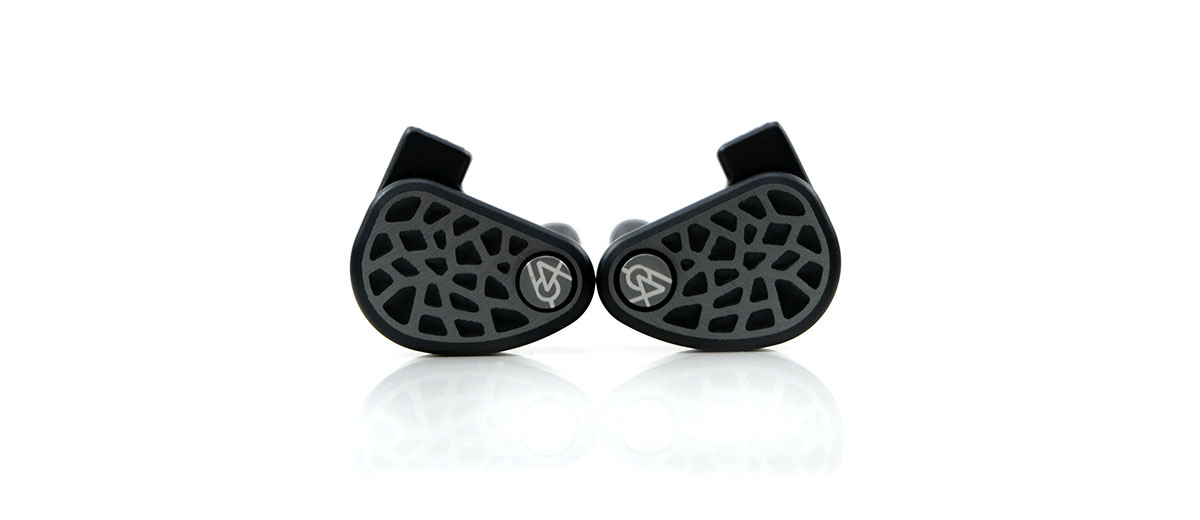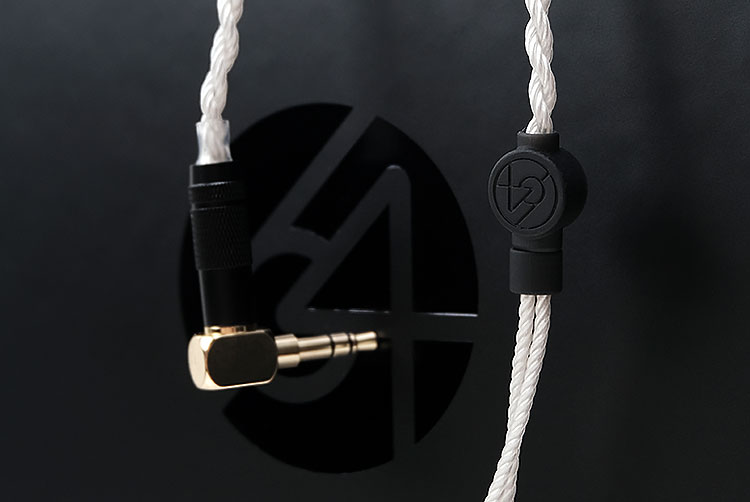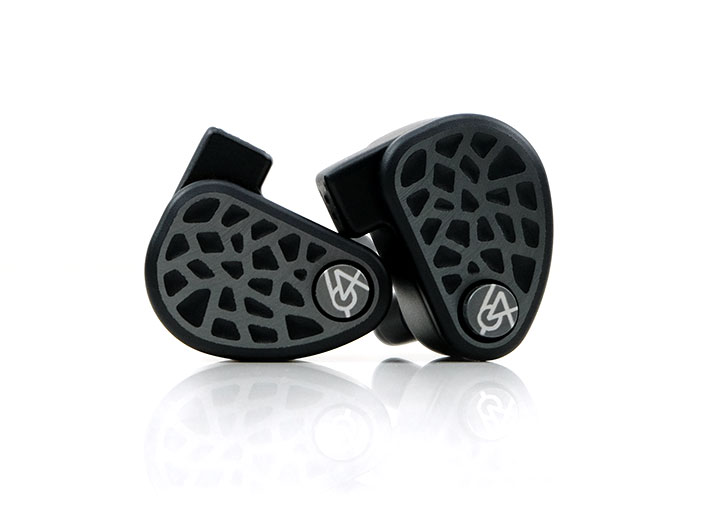U18s Stock Cable
Geometry
The U18s comes with a new stock ‘Silver’ cable which seems to be an upgrade on the Premium cable that came with the Nio but a step below the Silver Premium cable we reviewed separately that retails for $499. Currently, there seems to be no option to buy the new Silver cable separately.
The Silver cable is a 48″ 8-conductor pure silver-plated oxygen-free copper wire with a 65 strand 44AWG geometry and a very low impedance rating of 0.28Ω. It is wrapped in a very pliant transparent jacket so that SPC silvery tone comes shining through compared to the black of the Premium cable.
With that enhanced strand count the Silver is a little thicker and heavier than the Premium Cable but not quite as much girth as the Premium Silver’s 4-core 26AWG 200 strand geometry. Combined with a different braiding technique they do look a bit different externally despite both having a silvery finish.
Terminations & Handling
The Silver cable is terminated with 64 Audio’s hand-soldered 2-pin connectors and a very durable right-angled 3.5mm TRS gold-plated jack. The barrels and splitter are finished in black with the splitter a lightweight matte plastic design with branding on both sides and a matching chin cinch.
I find the Silver to handle a bit better than the Premium black cable that comes with the Nio. It has a bit less memory retention and handles a bit easier with a slightly improved microphonics performance above the splitter and zero noise below.
It also comes with low profile memory hooks that retain their shape with ease when manipulated so they will stay close to your ear which I tend to prefer.
Sound Impressions
Summary
If you are coming from the A18T and expecting a minor update in the U18s sound signature then get ready because I found this to be quite a changeup. I suspect the choices here will come down to personal preferences or simply a user-case scenario but certainly, the U18s sound signature is unique and quite distinct from the original.
The U18s main calling card is what I would call ‘its temperament’. What I mean by this is the way 64 Audio has carefully crafted a very natural tone to the U18s without sacrificing that world-class resolving sound of the A18t. It sounds controlled, complex, yet smooth and easy on the ear.
More so, the enhancements to the sound signature, especially in the low-end and midrange might just make this an even more enjoyable experience. I can see why this is a pitch to an events sound engineer. Their ears will not be ringing with this one, the fatigue levels should ideally be quite low, but it is also unlikely they will miss any key aspect of the performance.
Frequency Response
From a pure FR perspective, the U18s is lightly w-shaped using the stock m15 filter, becoming more emphasized around the 20-50Hz marker with the m20 filter and rolling off below the m15 module by up to 6-8dB in the same region. Beyond the lower-mids, (around 1k), the filters have less of a direct influence on the response curve.
From 100Hz you get a slow drop to around 700-800Hz so there is some mid-bass warmth creeping into the lower-mids but otherwise very nicely controlled and not too sharp on the cut post 200hz either. Instrumental positioning will be a little further back with they still retain an excellent bass fundamental as well as some solid space in which to breathe.
From 1k to 4Khz you get a moderate rise, perhaps not quite as pushed as the A18T’s peakier but narrower 2-3k bump but it does sound a little more consistent with the lower-mids and more spacious in this region also. Vocals are not as intimate as the A18t but do sound relatively forward for higher-pitched vocal mixes.
The U18s treble does have a fairly linear and smooth transition from the mids. Lower treble energy from 4-6k is relatively modest with more of 7-8k elevation and a minor 10k bump.
None of the U18s FR peaks are overly exaggerated across the board with the low-end perhaps the highest point but again, just 2-3dB higher so not overwhelming. Nevertheless, the U18s bass response is one of the more impressive all-BA low-ends out there.
Timbre
The U18s timbre is beautifully smooth with a slight even-harmonic bias but avoids sounding overly rounded with just enough top-end sparkle to retain a welcome degree of accuracy. This is in direct contrast to the brighter tone of the A18t which I would describe as vivid beyond 1k but not as weighted as the U18s sub-1k.
Sub-1k, the U18s benefits from an excellent BA bass response tuning that’s nimble, well defined, and at times can reach an impressively deep level. You can also enhance that power significantly with the m20 but unlike the A18t which has an m20 permanently screwed in, I tend to float between the m15 and m20 a bit more on the U18s.
The mX’s was my least favored of the modules. Its attenuation on the low-end seems to generally rob the U18s of a little ‘joie de vivre’ with far less power and PraT as well as a slightly lighter timbre through the mids as a direct result.
The U18s sub-bass won’t have quite the physicality or the broad ‘textural brushstrokes’ of the dynamic driver-laden tia Trió and Nio but it does sound more articulate and importantly, allowing enough space for the lower mids to shine.
Mids Quality
That’s perhaps one of the most satisfying aspects of the U18s tuning, the quality, and timbral coloration of the lower-mids instrumental notes. There is just enough warmth creeping in from the bass to give instruments such as bass guitar a nice natural and smooth tone. At the same time, they resonate very clearly with little in the way of bass bloom overshadowing them.
Vocals again just flow without sounding too sharp, too rounded, or nasal. Some might prefer the more immediate brighter timbre of the A18t but sometimes they can be too vivid, particularly with falsetto and head voice mixes, that they can dominate everything immediately below them. That means those beautiful lower-mids of the U18s sound a bit less distinct and natural on the A18t.
There is a slight diminution around 3-4k but feels nuanced. One can only presume that’s just to keep a minor check on the mid-high BA and tia high from injecting any potential harmonic resonance that could disrupt an otherwise very smooth transition into the treble.
That means upper mids percussion is more liquid than edgy with some nice control and enough air and sparkle to retain a pleasing harmonic balance. If you are coming from the peppy treble A18t, however, the U18s treble will be more on the relaxing side.
Staging
64 Audio has monitors that go deeper and sound more powerful such as the dynamic driver-infused tia Trió and the Nio. They also have monitors that seem brighter with more upper treble presence such as the A18t.
However, at least in terms of what I have experienced from 64 Audio to date, the U18s has possibly the most coherent and reference-like staging performance of all of those monitors mentioned.
Of their all-BA designs, the U18s low-end is one of their most impressive, not in terms of sheer quantity, but rather in how 64 Audio has managed to combine impressive BA power with a seriously excellent level of separation and speed.
And the transition into the lower mids is just so silky smooth with plenty of space for instruments to shine. There is a definite presence and power from rhythmic instruments to come to the fore in a more authoritative fashion compared to the A18t.
Vocals are a bit more neutral in times of imaging. There is a degree of forwardness to female over male to offset the slightly heavier low-end presence but not hugely intimate.
Headroom courtesy of the tia High is very good but again the emphasis is on smooth transitions and coherency so like the low-end it feels more controlled with good air rather than aggressive and forward.
Synergy
Efficiency
The U18s is rated at 8Ω and 106dB SPL which makes it a little less sensitive both on paper and in real-world testing compared to the A18T I have on hand here. It does seem to be of similar efficiency levels though compared to the newer Nio with the tia Trió a tiny bit more sensitive.
I do often find hard-hitting dynamic drivers in hybrids though to diminish the desire to pump up volume levels compared to BA but otherwise, the U18s is fairly efficient with most sources but not sensitive enough to explore background hiss with DAPs.
Even when switching over to 64 Audio’s TOTL balanced-terminated Premium Silver cable the higher noise floor of the likes of the HiBy R8 and FiiO’s M15 did not inject any distracting hiss into the U18s performance. If you plan on sticking with SE and 3.5mm TRS then you won’t have any pressing need for high volume levels either, even in low gain from similar DAPs.
Pairings
I tended to enjoy cleaner neutral DAPs with good dynamic range and a relatively punchy low-end compared to softer sounding sources with a degree of warmth. To further clarify the former general tends to sound excellent with the U18s if vocals are not too neutral or laid back.
The U18s vocal presence is good but not overly forward so DAPs like the HiBy R8 which have a flow fade almost from 1k onwards and less vocal power compared to the bass line do not gel as well as cleaner neutral vocal deliveries such as the FiiO M15.
Going up a level, vocal presence on the M15 felt a bit thin compared to the better body from the iBasso DX300 as well as the staging being slightly narrower on the U18s. I loved both, however, in the way they tease out a very responsive and well-defined low-end with the DX300 ending it in terms of weight and body.
Probably the best for midrange presence were the Lotoo PAW Gold Touch and iBasso’s DX220 MAX. Both have a bit of forwardness though the Touch had the better physicality with the U18s and the Max offered more air and headroom.
The final tested source was the LP P6 which I love in terms of how it can add a bit more flesh and texture into the U18s BA drivers though it will not add too much spice and energy into the U18s treble compared to the more neutral DAPs. This pairing is the genuine deal though for rendering the most natural bass and midrange performances.
Click on page 2 below for the stock cable, sound impressions, and pairings
Click on page 3 below for select comparisons and our verdict







